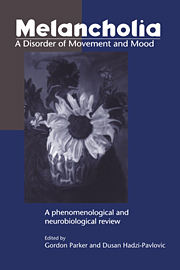Book contents
- Frontmatter
- Contents
- List of contributors
- Acknowledgments
- Introduction
- Part One Classification and Research: Historical and Theoretical Aspects
- Part Two Development and Validation of a Measure of Psychomotor Retardation as a Marker of Melancholia
- Part Three The Neurobiology of Melancholia
- The CORE Measure: Procedural Recommendations and Rating Guidelines
- References
- Author Index
- Subject Index
Introduction
Published online by Cambridge University Press: 04 August 2010
- Frontmatter
- Contents
- List of contributors
- Acknowledgments
- Introduction
- Part One Classification and Research: Historical and Theoretical Aspects
- Part Two Development and Validation of a Measure of Psychomotor Retardation as a Marker of Melancholia
- Part Three The Neurobiology of Melancholia
- The CORE Measure: Procedural Recommendations and Rating Guidelines
- References
- Author Index
- Subject Index
Summary
It may then be useful to investigate two or three symptoms of depression as a means of discovering the necessary biological processes responsible for their emergence and contribution to the syndrome of depression. This is likely to be the wish of the psychopathologist who seeks to understand the fundamental nature of depression.
– Costello (1993)More than a quarter of a century ago, Carney, Roth and Garside (1965) wrote that the “establishment of a classification of affective disorders commanding wide agreement among clinical practitioners and investigators is one of the most pressing needs of contemporary psychiatry.” We suggest that that need persists, and that the continuing lack of such a classification has both restricted and slowed pursuit of aetiologies and refinement of treatment approaches. Kendell (1989) has provided some historical analogies:
It was only after Sydenham had demonstrated that “the pox” was actually two distinct syndromes, chicken pox and small pox, that it was possible to predict with any accuracy who would almost certainly recover and who would remain scarred for life and was in danger of dying. And only after physicians had learned to distinguish between the renal and cardiac forms of dropsy was it possible to predict which patients were likely to benefit from digitalis.
An ongoing objective – that has alternately excited and frustrated researchers – has been to distinguish an assumed categorical depressive entity, with an imputed preferential neurobiological base.
- Type
- Chapter
- Information
- Melancholia: A Disorder of Movement and MoodA Phenomenological and Neurobiological Review, pp. 1 - 6Publisher: Cambridge University PressPrint publication year: 1996
- 2
- Cited by

